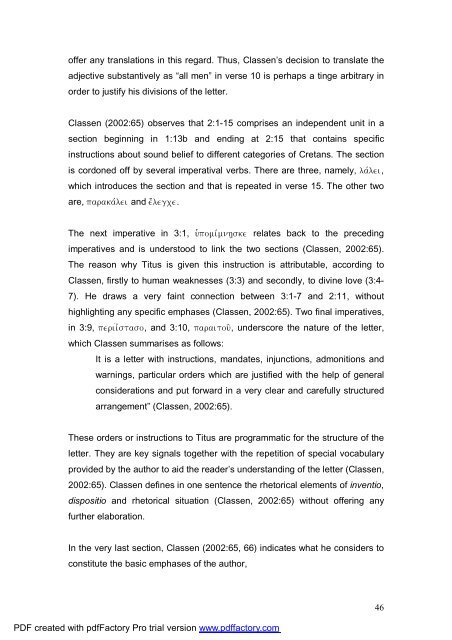A Text centred rhetorical analysis of Paul's Letter to Titus
A Text centred rhetorical analysis of Paul's Letter to Titus
A Text centred rhetorical analysis of Paul's Letter to Titus
Create successful ePaper yourself
Turn your PDF publications into a flip-book with our unique Google optimized e-Paper software.
<strong>of</strong>fer any translations in this regard. Thus, Classen’s decision <strong>to</strong> translate the<br />
adjective substantively as “all men” in verse 10 is perhaps a tinge arbitrary in<br />
order <strong>to</strong> justify his divisions <strong>of</strong> the letter.<br />
Classen (2002:65) observes that 2:1-15 comprises an independent unit in a<br />
section beginning in 1:13b and ending at 2:15 that contains specific<br />
instructions about sound belief <strong>to</strong> different categories <strong>of</strong> Cretans. The section<br />
is cordoned <strong>of</strong>f by several imperatival verbs. There are three, namely, lavlei,<br />
which introduces the section and that is repeated in verse 15. The other two<br />
are, parakavlei and e[legce.<br />
The next imperative in 3:1, uJpomivmnh/ske relates back <strong>to</strong> the preceding<br />
imperatives and is unders<strong>to</strong>od <strong>to</strong> link the two sections (Classen, 2002:65).<br />
The reason why <strong>Titus</strong> is given this instruction is attributable, according <strong>to</strong><br />
Classen, firstly <strong>to</strong> human weaknesses (3:3) and secondly, <strong>to</strong> divine love (3:4-<br />
7). He draws a very faint connection between 3:1-7 and 2:11, without<br />
highlighting any specific emphases (Classen, 2002:65). Two final imperatives,<br />
in 3:9, periivŸstaso, and 3:10, parai<strong>to</strong>u`, underscore the nature <strong>of</strong> the letter,<br />
which Classen summarises as follows:<br />
It is a letter with instructions, mandates, injunctions, admonitions and<br />
warnings, particular orders which are justified with the help <strong>of</strong> general<br />
considerations and put forward in a very clear and carefully structured<br />
arrangement” (Classen, 2002:65).<br />
These orders or instructions <strong>to</strong> <strong>Titus</strong> are programmatic for the structure <strong>of</strong> the<br />
letter. They are key signals <strong>to</strong>gether with the repetition <strong>of</strong> special vocabulary<br />
provided by the author <strong>to</strong> aid the reader’s understanding <strong>of</strong> the letter (Classen,<br />
2002:65). Classen defines in one sentence the <strong>rhe<strong>to</strong>rical</strong> elements <strong>of</strong> inventio,<br />
dispositio and <strong>rhe<strong>to</strong>rical</strong> situation (Classen, 2002:65) without <strong>of</strong>fering any<br />
further elaboration.<br />
In the very last section, Classen (2002:65, 66) indicates what he considers <strong>to</strong><br />
constitute the basic emphases <strong>of</strong> the author,<br />
PDF created with pdfFac<strong>to</strong>ry Pro trial version www.pdffac<strong>to</strong>ry.com<br />
46

















